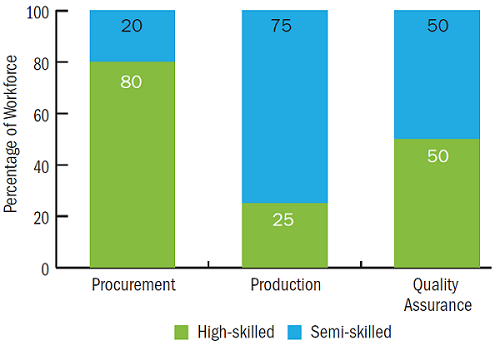Issue Brief
Employment Potential of Emerging Renewable Energy Technologies
Insights from the floating solar sector
Akanksha Tyagi, Neeraj Kuldeep, Madhura Joshi
March 2021 | Energy Transitions, Sustainable Livelihoods
Suggested citation: Tyagi, Akanksha, Neeraj Kuldeep, and Madhura Joshi. 2021. Employment potential of emerging renewable energy technologies: Insights from the floating solar industry. New Delhi: Council on Energy, Environment, and Water; Natural Resources Defense Council; and Skill Council for Green Jobs.
Overview
This issue brief explores the employment potential across project deployment cycles in the Floating Solar Photovoltaic (FPV) sector, an area that presents India with immense opportunities for its clean energy transition. Based on surveys and interviews with manufacturers, developers and engineering, procurement and construction (EPC) service providers, it generates insights on operation strategies, organisational structure and employed workforce at a project level. It also makes several recommendations to aid the growth of FPV technology in India.
To capture the employment potential of the sector, the brief divides the deployment of FPV solar projects into four stages: Business Development, Design and Pre-Construction, Construction and Commissioning (including the manufacturing of PV modules, floats and other equipment), and Operation and Maintenance. The data was collected from two small-scale (<1 MW) capacity projects – one near Mumbai, and another at Kochi airport – and one mid-scale (<10 MW) capacity project near Vishakhapatnam.
Key Highlights
- FPV technology involves installing solar photovoltaic bodies on water bodies and offers a number of advantages when compared with ground-mounted solar plants. But it also comes with challenges, including, for instance, the difficulty of maintaining plants that can only be reached by boat.
- If scaled up, FPV technology can help India’s clean energy transition and generate employment to reinvigorate the post-COVID-19 economy. The government has set a target of achieving 10 GW of FPV capacity by 2022.
Relative Proportions of High-Skilled and Semi-Skilled Workers Engaged in Production of a Mid-Scale FPV Plant

Location: Mudasarlova Reservoir, Vishakhapatnam, Capacity 2 MW
Source: CEEW and NRDC analysis
Employment potential across the four stages
- A small-scale plant requires 11 people for business development, and a mid-scale one requires 12. In the first case, business development activities are accomplished in a month, and the second takes 110 days. Individuals with significant experience and formal degrees undertake business development.
- The design and pre-construction of FPV plants require highly skilled workers, including civil, mechanical, hydraulic and electrical engineers. One of the firms surveyed employed six people for this project stage and another employed two.
- In a small plant, 33 people are involved in construction and installation, which lasts for a month. For a mid-scale plant, these activities take about 135 days and require 25 people (6 permanent and 19 contracted staff).
- The operation and maintenance of FPV plants are smoother when compared to ground-mounted solar plants. Maintenance cycles last for about 30 days for a small-scale project. For maintenance services, service providers contract a team of semi-skilled individuals to assist their permanent staff. At a mid-scale plant, this team comprises four permanent employees and 10 contractual workers.
Key Recommendations
- The Ministry of New and Renewable Energy (MNRE) should specify standards for photovoltaic (PV) modules used in the FPV sector and consider setting periodic targets for FPV capacity deployment.
- The Ministry of Skill Development and Entrepreneurship (MSDE) should offer training programs on relevant specialised topics such as marine architecture and hydraulic engineering.
- The Solar Energy Corporation of India (SECI) should initiate hydropower-linked FPV project tenders.
- The FPV industry should regularly release data on employment and skills.
A small-scale FPV plant (capacity <1 MW) directly employs 58 workers while a mid-scale (capacity <10 MW) plant 45, over the course of their deployment.







